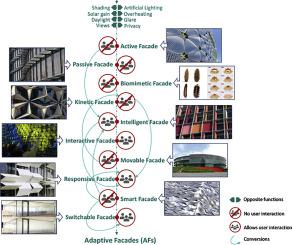当前位置:
X-MOL 学术
›
Autom. Constr.
›
论文详情
Our official English website, www.x-mol.net, welcomes your
feedback! (Note: you will need to create a separate account there.)
Design approaches and typologies of adaptive facades: A review
Automation in Construction ( IF 9.6 ) Pub Date : 2021-01-01 , DOI: 10.1016/j.autcon.2020.103450 Amir Tabadkani , Astrid Roetzel , Hong Xian Li , Aris Tsangrassoulis
Automation in Construction ( IF 9.6 ) Pub Date : 2021-01-01 , DOI: 10.1016/j.autcon.2020.103450 Amir Tabadkani , Astrid Roetzel , Hong Xian Li , Aris Tsangrassoulis

|
Abstract The most ambitious challenge for designers is an effective shading system that is able to keep the balance between the daylight harvesting and view out maximization while minimizing discomfort risks and building's energy load. In the literature, several definitions exist for an adaptive facade and many terminologies were introduced and used interchangeably. Therefore, this paper aims to distinguish the existing adaptive system typologies based on their key characteristics. In addition, a review based on a systematic search is conducted to outline possible design approaches towards non-conventional adaptive facades (AFs) through simulations at early stage of design. As the main research outcome, most of the studies evaluated indoor daylighting level and discomfort glare through parametric tools, while none of them proposed a specific control strategy to predict non-conventional adaptive facades' performance. These observations emphasize existing research gaps in this field that can affect the applicability of such facades in real practices.
中文翻译:

自适应外墙的设计方法和类型:综述
摘要 设计师面临的最大挑战是一个有效的遮阳系统,它能够在日光收集和视野最大化之间保持平衡,同时最大限度地减少不适风险和建筑物的能量负荷。在文献中,自适应立面存在多种定义,并且引入了许多术语并可以互换使用。因此,本文旨在根据其关键特征区分现有的自适应系统类型。此外,还进行了基于系统搜索的审查,以通过在设计早期阶段的模拟来概述针对非常规自适应外墙 (AF) 的可能设计方法。作为主要研究成果,大多数研究通过参数化工具评估室内采光水平和不适眩光,而他们都没有提出特定的控制策略来预测非常规自适应外墙的性能。这些观察结果强调了该领域现有的研究空白,这些空白可能会影响此类立面在实际实践中的适用性。
更新日期:2021-01-01
中文翻译:

自适应外墙的设计方法和类型:综述
摘要 设计师面临的最大挑战是一个有效的遮阳系统,它能够在日光收集和视野最大化之间保持平衡,同时最大限度地减少不适风险和建筑物的能量负荷。在文献中,自适应立面存在多种定义,并且引入了许多术语并可以互换使用。因此,本文旨在根据其关键特征区分现有的自适应系统类型。此外,还进行了基于系统搜索的审查,以通过在设计早期阶段的模拟来概述针对非常规自适应外墙 (AF) 的可能设计方法。作为主要研究成果,大多数研究通过参数化工具评估室内采光水平和不适眩光,而他们都没有提出特定的控制策略来预测非常规自适应外墙的性能。这些观察结果强调了该领域现有的研究空白,这些空白可能会影响此类立面在实际实践中的适用性。











































 京公网安备 11010802027423号
京公网安备 11010802027423号